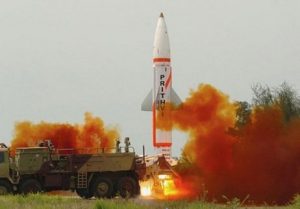India’s Strategic Forces Command (SFC) test launched a short-range nuclear capable ballistic missiles at night as part of its annual training cycle to validate the combat readiness of the Indian Army’s missile forces.
The Prithvi-II tactical surface-to-surface short-range ballistic missiles was test fired from the Integrated Test Range (ITR) on Dr. Abdul Kalam Island in the Bay of Bengal off the coast of Odisha at nighttime on December 3, according to an Indian defense source.
It was the second test firing of a Prithvi-II ballistic missile at night in less than two weeks.
“Today’s trial of Prithvi-2 missile was successful and the test met all parameters,” an Indian defense official was quoted as saying by the Economic Times. “It was a routine trial.”
As during the earlier trials in November, the night-time launch was overseen by the SFC and the Defense Ministry’s Defense Research and Development Organization (DRDO). The missile was randomly selected from the production stock.
“The trajectory of the missile was tracked by radars, electro-optical tracking systems and telemetry stations by the DRDO along the coast of Odisha,” the source added.
As I reported elsewhere:
Prithvi-II is a single-state, liquid-fueled short-range ballistic missile, developed by DRDO in the 1990s and early 2000s under the so-called Integrated Guided Missile Development Program. It was first introduced into service in 2003. The missile has an operational range of around 350 kilometers and can alternatively be armed with 500 to 1,000 kilogram conventional or nuclear warheads.
The last nighttime test launch of a Prithvi-II took place in June 2019. Another daytime user trial took place in February 2018.
The Indian military has tested a number of different missiles in recent weeks as part of its annual training cycle. On December 1, the first-ever night user trial of the Agni III nuclear-capable intermediate-range ballistic missile took place. The test reportedly ended in failure.
A test launch of an Agni-II medium- to intermediate-range ballistic missile occurred on November 16. The missile’s maximum range is estimated to be somewhere between 2,000 and 3,000 kilometers and it can be fitted with a conventional or nuclear warhead of up 1,000 kilograms. It was first deployed in 2004 and is both road and rail mobile.
The Agni-II is meant to constitute the backbone of India’s land-based nuclear deterrent, however, there has been an ongoing concern that the two-stage solid-fueled missile entered service prematurely.
Notably, DRDO was also expected to test fire a K-4 intermediate-range, nuclear-capable submarine-launched ballistic missile (SLBM) from a submerged platform off the coast of Andhra Pradesh in southeastern India earlier in October. However, no test has taken place to date.

































